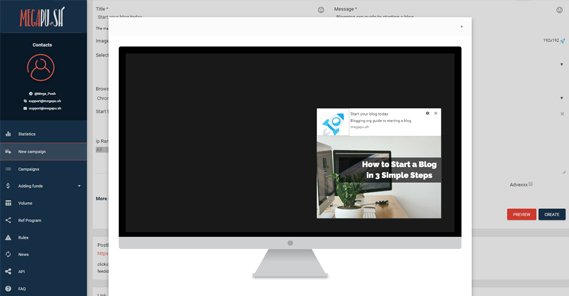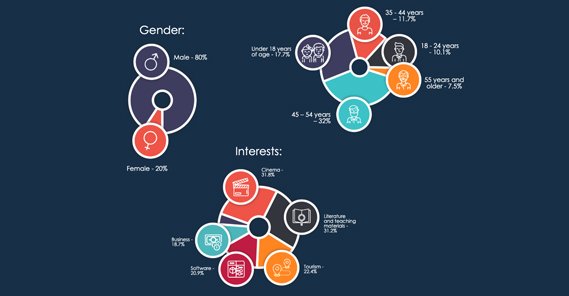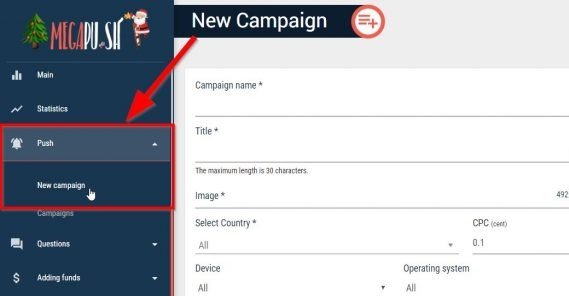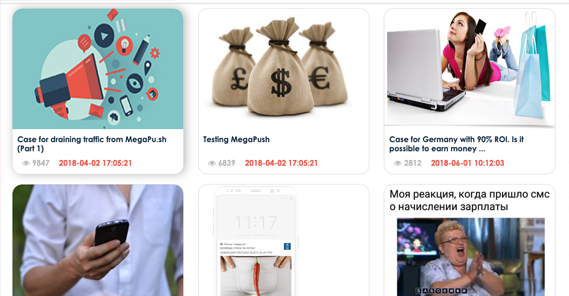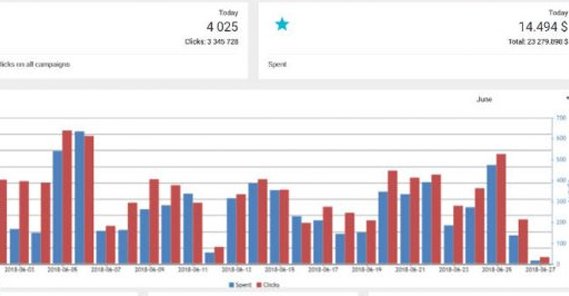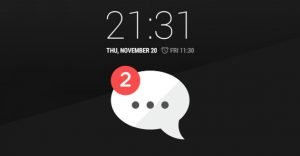MegaPush Review – A Unique Push Notification Ad Network
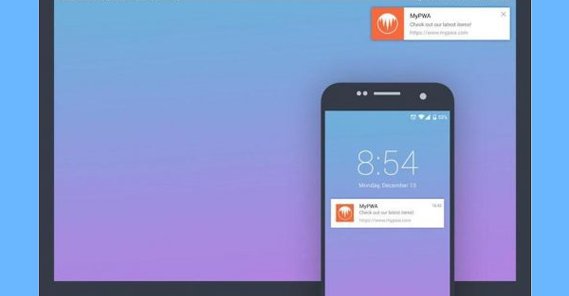
With the increasing prevalence of mobile devices and the fact that now nearly 60% of web traffic is from mobile users, it makes sense to start catering to mobile more and more in everything from web design to content to advertising.
Traditional display ads, banners and lightboxes and slide-ins and pop-unders, these all rely on the unique multi-windowed approach to computer usage coming from desktop platforms. Mobile devices have less available screen space and less room for pop-style additional windows, so advertising has to adapt.
One unique advantage mobile devices bring to the table for advertisers is push notifications. If you can use push notifications for advertising, you can take advantage of a unique mobile-specific channel that is otherwise left for, well, notifications.
What are Push Notifications Exactly?
If you have a smartphone, you’ve experienced push notifications. Any time you see a message or icon on your lock screen, or an app icon in your top nav bar, you’re seeing a push notification. They come from a wide range of sources, but mostly apps. A game might send you a notification when they’ve pushed a patch, or when your stamina bar refills. A restaurant app will message you when a special deal is active or when your reservation is ready. Messaging apps like Facebook Messenger will leave you a notification when a new message comes in.
Push notifications are powerful because every mobile user is used to checking them. In a way it’s like email in that sense, but push notifications don’t have an inbox to be ignored or a spam filter to weed out the messages.
Using push notifications for marketing is a relatively new, untapped channel. That’s what makes MegaPush a key player: they were the first to build a complete advertising network around them.
These days, push notifications are an increasingly available marketing channel. Networks like MegaPush are springing up, but more importantly, existing and established ad networks are starting to add push notifications as another ad format to their networks.
What is MegaPush?
As you probably guessed, MegaPush is an advertising network unlike any other. They were the first push notification focused advertising network, and are still the largest such network focused entirely on push notifications. They were founded in 2017, so you know at least their technology is up to date.
MegaPush is nice enough to publish a neat infographic on their homepage showcasing their demographics and audience niches right up front. Their audience is (roughly) 80% male, with a majority of users falling into either the under 18 age group or the 45-54 age group, with 35-44 taking a middle ground. In terms of niches, the categories that are broad enough to have a full segment of their pie chart are cinema, literature and teaching, tourism, software, and business. Other niches may not have as much traffic, but are certainly still available.
So what advantages does MegaPush bring to the table? Here are some of their selling points, beyond the demographics.
- Global traffic.
- CPC bidding.
- Minimum price per click of $0.001.
- Fully implemented tracking.
- 12+ million clicks per day.
Now, a couple of these may be questionable as positives, but we’ll talk about that some more in a moment. The core fact remains: push notification marketing is relatively new, and MegaPush is the most prominent player in a largely untapped market. They are poised to hit the big time, if they navigate the early years where most ad networks fail.
I should also mention here that, as a global company, MegaPush works with a variety of payment processors, including Qiwi, MNP, Ibox, Wire, Beeline, and Visa, but they do not mention some of the big names, like Stripe or PayPal. For those of you who are into the crypto craze, they accept Bitcoin as well.
Using MegaPush
Getting started with MegaPush is actually very easy. There are no traffic minimums or minimum spends to be an advertiser. All you need to do is register and deposit $100 into your account to get up and running. Even the sign-up form is easy, simply asking for a name, password, and basic contact information.
Before you get too far into it, though, make sure it’s a network that works with your niche. As with a lot of advertising networks, MegaPush has a rules document that includes a list of niches that aren’t allowed to advertise through their platform. It’s mostly the usual, no illegal items or materials, nothing political or religious, nothing sexual or adult. You can read their full list of rules here.
Actually creating a campaign is dead simple. If you’ve ever looked at any other advertising network before, you should know more or less what to do from the moment you’re in their dashboard.
First, click the new campaign entry on the left column. This opens the main window to the new campaign pane. Fill you information: your campaign name, link, title, message, image, icon, and targeting information. For targeting, you can choose country, device, and OS. Choose your start and stop times and your budget. You can also choose IP ranges, traffic feeds, and ISPs. On the other hand, there are no interest or demographic targeting options.
This is where one of the biggest potential drawbacks of push notification advertising makes itself clear. Push notifications are, if you haven’t noticed before, very short. They only give you 30 characters for your title and 45 characters for your description. That’s less than 1/4th of a tweet! You’re able to use emoji if you want, so that can help a bit, but you’re still very heavily restricted in the amount of space you have available.
This is, however, an inherent limitation in the ad format, due to how much space a push notification takes up on a mobile device. There’s no way to expand that until Apple and Google collectively decide to expand the size of push notifications. Will that ever happen? Who knows!
Once you have your ad configured the way you want it, simply submit it. As long as you have money in your account, it will be submitted to the moderation queue, which takes roughly half an hour before your ad is reviewed and either accepted or rejected. MegaPush has a very high acceptance rate. Basically all they check for is if you violate any of the rules listed upon that rules document, and they will only reject for violations of those rules. Keep in mind, however, that three violations will result in the closure of your account, so don’t push it.
Drawbacks, Warning Signs, and Problems
Now, it’s not all sunshine and roses in the lands of the MegaPush. I have a few issues with it as an advertising network.
First and foremost, the bottom chunk of their homepage is covered with case studies copied from people who have tested out their service. Unfortunately, most of those case studies are, well, bad. A lot of them are Russian, for one thing, and almost all of them show off losing money in mediocre tests. They talk about targeting third-tier countries for a few cents with really bad, literally Google translated advertising. None of it is even applicable to the kinds of advertising I run.
I wouldn’t even be surprised if some of these “case studies” are bare minimum experiments created specifically to get MegaPush to syndicate the post on their site, giving that backlink to the site that did the study. Since most of them are spending very low amounts of money, and they’re operating in niches like dating and pharma, it doesn’t inspire confidence.
The fact that the rules and FAQ pages for MegaPush are in a very “engrishy” style also doesn’t inspire confidence. The fact is, MegaPush is a foreign-created and ESL company that is using English as a trade language, not a native language. There’s nothing wrong with that, but it comes with certain connotations and a history on the web.
An advertising network lives and dies based on the balance of its publishers and advertisers. Too many advertisers means competition drives pricing so high that it no longer becomes feasible. Too many publishers and the opposite happens. If the publishers are not high enough in quality, the traffic the advertisers get is garbage and they abandon the platform. Conversely, if the advertising is poor quality or spammy, publishers start to back out.
Smart advertising networks can solve this problem through some aggressive filtering. I can understand MegaPush holding off on this filtering as long as they can; it involves cutting out a lot of publishers and advertisers. If they don’t have enough high quality members of their respective rosters, they won’t be able to survive the purge. They need to build before they can prune.
The break point, in my mind, will probably come in 2-3 years. At that point, we will known whether MegaPush wants to become one of the big players, or if they’re going to content themselves with low quality traffic and ads. My hunch is that the currently existing high quality advertising networks are going to offer push notifications – some do already – and that MegaPush won’t be able to compete. I’ll be happy to be proven wrong, but that’s the way I feel the wind blowing.
Get the Most Out of MegaPush
If you’re determined to make use of MegaPush – and it’s not a bad idea, especially if you just want to get experience with a new ad format with very low pricing – you can play around quite a bit to optimize your traffic.
Here’s the thing with MegaPush: the traffic is generally quite low quality, but so long as you have an offer that can be claimed in your target zones, it very likely will be claimed eventually. Even really bad ads can have a decent return, simply because there’s very little banner blindness for push notification ads just yet.
The first and best route for optimization you have is feed optimization. MegaPush has over 50 individual traffic feeds, but you need to actually be tracking the {feedID} parameter in your advertising to be able to see what traffic you’re getting from what feeds. Without that parameter, everything is just lumped into one record.
Basically, run your ads with no feed targeting, then pick out the top performing feeds and add those to your next round of targeting. Alternatively, edit your existing campaign to remove the feeds that don’t perform well enough.
Device targeting is useful as well. Remember that, while push notifications are primarily a mobile innovation, they are available on desktops as well. The trick is, push notifications on desktop are a lot harder to get, since they require an opt-in on the user’s part rather than being a natural part of mobile usage. I find that desktop push notifications are very unlikely to convert, though it’s not completely unheard of. At the very least, run different campaigns for mobile and desktop, so you can optimize them individually.
Have you used MegaPush? Have you experimented with push notification ads on other platforms? Let me know in the comments how your experiences have gone. I’d like to see if the case studies they publish are typical, or if a savvy user can make more out of it than they make it seem.
 ContentPowered.com
ContentPowered.com
